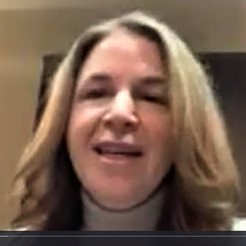
Dealing With Washington Wildfires
Hillary Franz--Washington State Commissioner of Public Lands

Hillary Franz was our program on September 16. She is the Washington State Commissioner of Public Lands. It is a statewide elected office, and she heads the Washington State Department of Natural Resources. The Department is charged with protecting and managing nearly six million acres of public lands in Washington State – from coastal waters and aquatic reserves, to working forests and farms, to commercial developments and recreation areas. It has the largest wildfire fighting force in the State.
In the aquatic management area, it leases to the ports and manages commercial shellfish production on those lands. Funds received from the leases go to such things as salmon habitat and public access. It also manages all the state-owned lands of about 3 million acres including forests and agriculture. There are also some residential and commercial properties. The State recently acquired the property where Bartell Drugs is located, in Arlington. Funds generated from these lands go to school funding at all levels, and to counties for such things as libraries and public safety.
The DNR also makes some of the state property available for recreation and it oversees geology, including mining and planning for dealing with natural disasters such as slides, earthquakes, volcano activity etc.
Recently, 6 out of the last 7 years, dealing with wildfires has been a major challenge. So far this year there have been over 1750 fires with over 640,000 acres burned. The fire season has begun earlier—this year in March. It has been non-stop since early July. The drought in the west has been the largest contributing factor resulting in more fires in western Washington. About 30% now are on the west side of the Cascades. Of all the fires about 90% are from man made causes, such as debris burns that get out of control.
In response to the need, the DNR has sought to upgrade its 7 Vietnam era helicopters. It has also sought funds to hire more firefighters. Air support attacks fires as soon as there is visual smoke. The result, for example, is that only about 25 of the 1750 fires have been significant in size.
Efforts have also been made to get to some of the roots of the problem. Forrest health is one of the factors. In Eastern Washington there is already about 2.7 million acres of timber that is dead or is dying. More than half of that is on federal lands. The DNR has set a goal of 1.25 million acres of reforestation, now on a 10-year cycle.
Climate change has resulted in it being much warmer and dryer earlier in the year on both sides of the Cascades. However, failure to manage our forests has been one of the contributing causes of the fires. Efforts are underway to reduce the amount of fuel for the fire by increasing spaces between healthy trees. Sometimes this involves prescribed fires. About 400,000 acres have been treated in the last 7 years. This is a significant increase.
In addition to State lands, there is a need in the federal forests to do similar management. Almost all the major fires in the western United States involves national forests.
Some new industries have developed in our State in response to the State’s-forest health plan. Smaller trees and even burned trees can be used for building materials. Waste material can now be turned into usable suitable soil for agriculture and pellets.
This last year, working with the legislature, the State is making one of the largest investments in wildfire response, forest management, and community resilience in its history. This will help in quicker response to fires and in recovery of the forest. Working with private landowners, tragedies like the one where the community of Malden was largely destroyed can be avoided by reducing the fuel around improvements.
Like all of our programs on Zoom, this one was also recorded and you can view it on our YouTube channel. For a link, click HERE.


